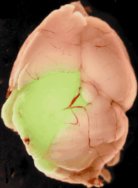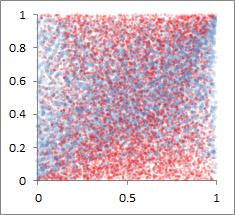 Medulloblastoma (MB) is a cancer of the cerebellum – it is most common in children, but can also arise in adulthood. A subset of human MBs is driven by Hedgehog (Hh)/Gli signaling, and several mouse models with increased Hh signaling develop MB. Image on right shows a brain of a mouse mutant that has ectopically activated Hh signaling. A large tumor marked with green fluorescent protein has grown on the left side of the cerebellum (Oliver et al., 2005). The cells that give rise to Hh-dependent MBs appear to be the highly proliferative cerebellar granule cell progenitors.
Medulloblastoma (MB) is a cancer of the cerebellum – it is most common in children, but can also arise in adulthood. A subset of human MBs is driven by Hedgehog (Hh)/Gli signaling, and several mouse models with increased Hh signaling develop MB. Image on right shows a brain of a mouse mutant that has ectopically activated Hh signaling. A large tumor marked with green fluorescent protein has grown on the left side of the cerebellum (Oliver et al., 2005). The cells that give rise to Hh-dependent MBs appear to be the highly proliferative cerebellar granule cell progenitors.
 We wanted to identify novel genes that contribute to MB pathogenesis. To that end, we studied the transcriptome of granule cell progenitors cultured in the presence of Hh. We found that some genes were upregulated both in Hh-treated progenitor cells and in mouse MB models, but were not upregulated in human Hh-driven MB samples. This finding called into question the utility of mouse models in the study of human MB. Image on left shows correlation in expression percentile ranks between genes from Hh-induced granule cell progenitors and mouse medulloblastoma samples (blue) and Hh-induced granule cell progenitors and human medulloblastoma samples (red). While blue dots are enriched on the diagonal, as expected, red dots are not. The reasons for this discrepancy are currently unknown.
We wanted to identify novel genes that contribute to MB pathogenesis. To that end, we studied the transcriptome of granule cell progenitors cultured in the presence of Hh. We found that some genes were upregulated both in Hh-treated progenitor cells and in mouse MB models, but were not upregulated in human Hh-driven MB samples. This finding called into question the utility of mouse models in the study of human MB. Image on left shows correlation in expression percentile ranks between genes from Hh-induced granule cell progenitors and mouse medulloblastoma samples (blue) and Hh-induced granule cell progenitors and human medulloblastoma samples (red). While blue dots are enriched on the diagonal, as expected, red dots are not. The reasons for this discrepancy are currently unknown.
Questions that we are trying to resolve:
Why are the transcriptional profiles of Hh-driven cancer so different between mouse and human?
How can we identify individual genes or gene expression patterns that are regulated by the Hh and other oncogenic pathways in a conserved way?
What genes are the core effectors of Hh signaling in human cancer or can be used as reliable disease biomarkers?